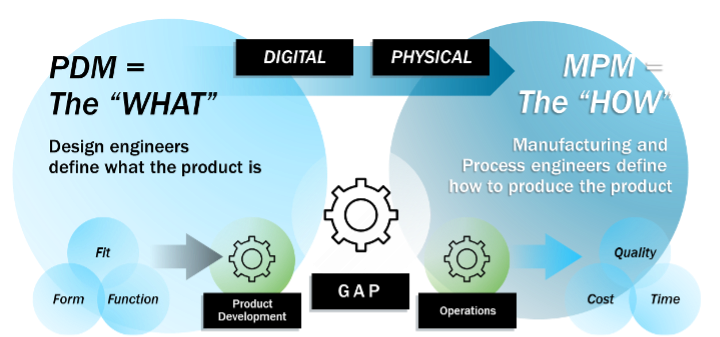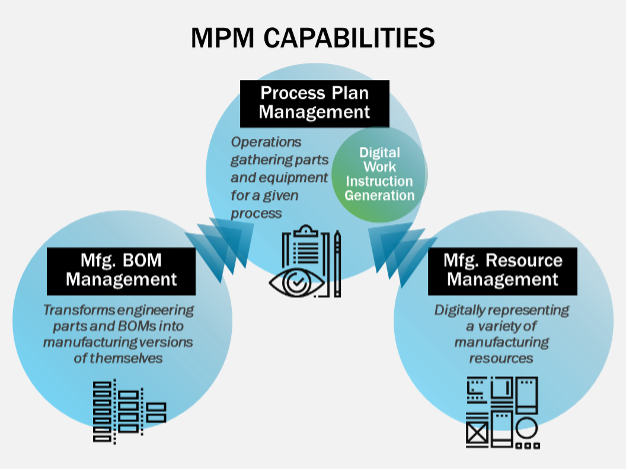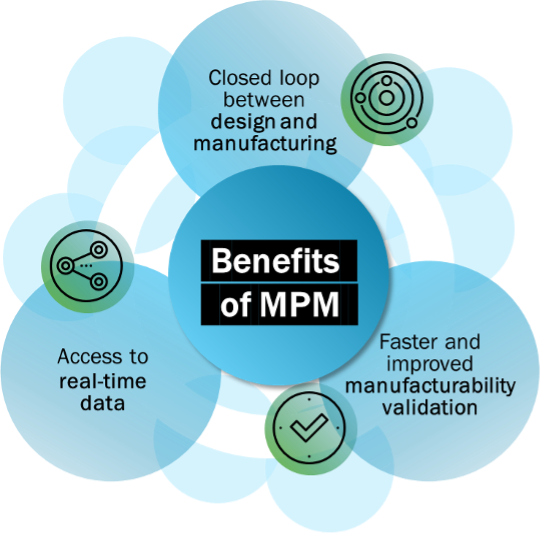Manufacturing Process Management within PLM
The key to a closed loop between product design and manufacturing
Since the 1990s, as enterprise systems started to develop and grow in popularity, companies began adopting different platforms to manage their processes and data. However, given the basic maturity of technology and scarce diversity at the time, it became common to use a single system to manage all streams of work and enterprise data. This led to companies dealing with maintaining overcomplicated, expensive systems that do not provide the expected value.
Fortunately, the purpose of different systems is much clearer today, enabling us to extract maximum value from diverse data sets, simplify enterprise processes and vastly improve collaboration between different teams. This means keeping everyone in the process aligned with the latest information. This includes R&D, design engineering, quality, procurement, manufacturing engineering and the production lines themselves.
This becomes particularly beneficial in the realm of Manufacturing Process Management (MPM), which requires people from all the above areas, and more, to collaborate on a daily basis.
What is Manufacturing Process Management?
Manufacturing Process Management (MPM) is the discipline that focuses on administering all resources, people and procedures necessary for manufacturing a product, with all its variations across multiple locations. Ideally, MPM is part of Product Lifecycle Management (PLM) along with product development data. This enables an organization to close the loop between product design and manufacturing, in which design engineers define what the product is, while manufacturing and process engineers have instant access to the latest data to define and adapt how to produce, maintain, repair, or verify a product.

The power of MPM as part of PLM is incredible. It allows the engineering bills of materials (EBOM) to be used as the base to generate manufacturing bills of materials (MBOM). Furthermore, it keeps a link between both versions of the BOM as changes occur in the design, allowing changes to trickle down in a simple fashion. Along with managing BOMs, MPM also manages resources, such as tools, skills, work centers and plants.
Why Should Work Instructions and Manufacturing Processes be Managed in PLM?
A common digital ecosystem for manufacturing processes is composed of several layers of system information. This is where we can find production data at its lowest level going up to management and where areas such as marketing and strategy make the most important decisions for a business.
Both PLM and ERP are part of the business layer which serves as an input for this top-most, decision-making level. PLM handles all the product-specific information, along with its historical change traceability data, while ERP uses this information and ties it in with other modules such as finance, operations and procurement to handle all the associated transactional activities.
It’s important to note that a PLM system will usually need to be properly defined before integrating it with an ERP system, as the latter is tied up across enterprise-wide business areas and includes data separate from PLM. Both systems use input from Manufacturing Execution Systems (MES) and other manufacturing-specific systems, which form a key pillar of MPM.
MPM Capabilities
As mentioned earlier, a key aspect of MPM is managing resources, people and procedures. Let’s go a level deeper into the manufacturing data that can, and should be, managed within PLM to obtain maximum value.

- MBOM Management: MPM provides the ability to transform engineering parts and BOMs into manufacturing versions of themselves. This means we can add a level of detail to illustrate how a product should be manufactured, even at a production site or even line level.
- Resource Management: Another crucial component of process management is tracking which resources will be needed to fulfill a specific activity. MPM provides the capability of digitally representing a variety of resources, such as plants, work centers, tools, skills and process materials. These can be reused as needed to provide a higher level of detail in the process design.
- Process Plan Management: A process plan is the digital grouping of operations needed to manufacture, repair, maintain or verify a specific product. The operations that compose a process plan can be organized to be executed in parallel or sequentially, depending on what that process requires. Process plans may also include standard processes and/ or standard operations, which represent an independent set of steps that have already been validated in real life and that may be leveraged by distinct processes, such as a cleaning procedure.
Work Instruction Generation
We’ve already mentioned how MBOMs, resources and process plans can be managed within MPM, but managing them in isolation does not provide maximum value. However, when they are combined and reference each other within a process plan, a very powerful and detailed work instruction can be generated.
A work instruction is a detailed step-by-step guide that tells an operator what to do, where to do it and how. This work instruction may also be enriched with reference diagrams or CAD drawings and 3D models that will provide additional guidance to improve effectiveness on the assembly line.
Benefits of MPM

While organizations commonly recognize the benefits of PLM from a product design standpoint, such as shorter time to market, reduced compliance risks and centralized data, the benefits list grows when we exploit the power of manufacturing process data in PLM.
Closed Loop between Design and Manufacturing
As product design evolves and improves and the available technology advances, its manufacturing process must be adapted accordingly. Having MPM data within PLM allows for product design data to be put through a change process in parallel with process plans, resources, and manufacturing BOMs.
This capability enables the business to perform a single, more detailed impact assessment that encompasses both product and manufacturing aspects. This requires engineering and manufacturing departments to increase their communication, which translates into lower quality risk, less rework and reduced cycle time in manufacturing updates, among other benefits.
Faster and Improved Manufacturability Validation
With improved communication and relevant data availability, flags are raised earlier about the impact of a design change on manufacturing. Whether it is a need for facility rearrangements, supplier changes, different skills or stock replenishment/use-up, it can be predicted before a new product design is released to production. With this, product manufacturability can be validated early, quickly and comprehensively which allows an organization to avoid delays, rework and scrap.
Access to Real-Time Data
With all product design and manufacturing process data in the same system, updated work instructions with the latest manufacturing information is accessible to shop floor workers as soon as the process and MBOM are released for production. This avoids investing time in sending information from one system to another, waiting for approval and then printing everything out.
Unleash the Potential
By incorporating MPM as part of your PLM system, you’ll be building a robust digital backbone that gives your company the potential to implement other advanced technological projects to improve your operations even more. This can include resource optimization as well as simulations and emulations
- Resource Optimization: Incorporate Smart Connected Operations (SCO) technology that leverages information regarding skills, tools, stations, and other kinds of resources to make sure they’re optimally available and scheduled for efficient production, minimizing cost and maximizing output.
- Manufacturing process emulation and simulation: Leverage CAD data stored within PLM to create simulations and emulations of how products will be produced. With this, you can create an accurate digital representation of the manufacturing process that may be used to improve overall throughput, reduce material scrap and optimize resources. At the same time, through the required scenario testing, you can validate that your shop floor layout is optimal before making any investments or long-term commitments.
What's Next?
As technology has matured over time, we now have the right tools at hand to move away from incorrect system usage and towards best-in-class practices. With this, we can exploit the potential of Product Design and Manufacturing Process data together within PLM systems, providing benefits in quality, supply chain planning and finance, among other areas, as well as opening the door for more advanced technologies that will help your company obtain the best possible results.
We know changing the current way of working can be challenging and at times seem impossible. Don’t be afraid to take the first step by carrying out an assessment, building a roadmap and developing an MVP to ensure scalability and confirm your business case. Choose to take the chance, but most importantly, choose to reap the benefits of MPM within PLM.


